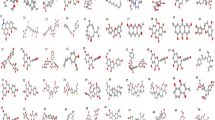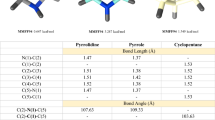Abstract
Purpose
Prostate cancer is the most common non-cutaneous cancer suffered by men and the second leading cause of cancer-related deaths in men. The efficacy of current therapies have been reported to vary from patient to patient and have been accompanied by varying degrees of side effects. This study aimed to design novel compounds with potent cytotoxic activity and lesser toxicity against prostate cancer.
Method
A Quantitative Structure Activity Relationship (QSAR) model was built to model the cytotoxic activity of arylpiperazine compounds against LNCAP prostate cancer cell line. The built QSAR model was used to design and predict the cytotoxic activity of novel derivatives via the ligand base design. The pharmacokinetic properties of the designed compounds were predicted using the pKCSM tool and their molecular docking interaction with the androgen receptor was investigated using PyRx and Discovery Studio software.
Result
The QSAR model built had statistical parameters; R2 = 0.7588, R2adj = 0.7014, Q 2cv = 0.6394 and R2ext = 0.6099 which met statistical benchmarks for stable and robust model. 29 new arylpiperazine compounds were designed and 20 were observed to be more potent than the template compound. The ADMET properties of nine compounds were observed to be significantly better than that of the template and were comparable to those of standard drugs apalutamide, bicalutamide and abiraterone. Molecular docking studies revealed that the compounds primarily form electrostatic and hydrophobic interactions with the androgen receptor having a binding affinity of – 7.45 to – 8.80 kcal/mol.
Conclusion
This study present compounds which show great potential as excellent leads for the design of novel prostate cancer drugs








Similar content being viewed by others
Availability of Data and Materials
The datasets generated during and/or analyzed during the current study are available from the corresponding author on reasonable request.
References
Cathcart P, Murphy DG, Moon D, Costello AJ, Frydenberg M (2011) Perioperative, functional and oncological outcomes after open and minimally invasive prostate cancer surgery: experience from Australasia. BJU Int. https://doi.org/10.1111/j.1464-410X.2011.10053.x
Salinas CA, Tsodikov A, Ishak-Howard M, Cooney KA (2014) Prostate cancer in young men: an important clinical entity. Nat Rev Urol 11(6):317–323. https://doi.org/10.1038/nrurol.2014.91
White M, Holman DM, Boehm JE, Peipins LA, Grossman M, Henley SJ (2014) Age and cancer risk: a potentially modifiable relationship. Am J Prev Med 46(301):S7-15. https://doi.org/10.1016/j.amepre.2013.10.029
Rawla P (2019) Epidemiology of prostate cancer. World J Oncol. 10(2):63–89. https://doi.org/10.14740/wjon1191
Keyes M, Crook J, Morton G, Vigneault E, Usmani N, Morris J (2013) Treatment options for localized prostate cancer. Can Fam Phys 59:1269–1274
DeSantis CE, Miller KD, Sauer AG, Jemal A, Siegel RL (2019) Cancer statistics for African Americans. CA Cancer J Clin. https://doi.org/10.3322/caac.21555
Eeles R, Benafif S (2016) Genetic predisposition to prostate cancer. Br Med Bull 120(1):75–89. https://doi.org/10.1093/bmb/ldw039
Mohs RC, Greig NH (2017) Drug discovery and development: Role of basic biological research. Alzheimers Dement (N Y) 3:4. https://doi.org/10.1016/j.trci.2017.10.005
Chen H, Yu Y, Tian X, Wang C, Qian Y, Deng Z, Zhang J, Lv D, Zhang H, Shen J, Yuan M, Zhao S (2018) Synthesis and biological evaluation of arylpiperazine derivatives as potential anti-prostate cancer agents. Bioorg Med Chem Lett. https://doi.org/10.1016/j.bmc.2018.11.029
Chen H, Wang C, Sun T, Zhou Z, Niu J, Tian X, Yuan M (2018) Synthesis, biological evaluation and SAR of naftopidil-based arylpiperazine derivatives. Bioorg Med Chem Lett 28:1534–1539. https://doi.org/10.1016/j.bmcl.2018.03.070
Tripathi RB, Jain J, Siddiqui AW (2018) Design of new peroxisome proliferators gamma activated receptor agonists (PPARγ) via QSAR based modeling. J Appl Pharm Sci Res 1(1):23–26. https://doi.org/10.31069/japsr.v1i01.13059
Arthur DE, Uzairu A, Mamza P, Abechi SE, Shallangwa GA (2018) Insilico Modelling of Quantitative Structure-Activity Relationship of Pgi50 Anticancer Compounds on k-562 Cell Line. Cogent Chem 4:1432520
Becke AD (1993) Becke’s three parameter hybrid method using the LYP correlation functional. J Chem Phys 98:5648–5652
Abdullahi M, Uzairu A, Shallangwa GA, Mamza P, Arthur DE, Ibrahim MT (2019) An Insilico modelling study on some C14-urea-Tetrandrine derivatives as potent anti-cancer against prostate (PC3) cell line. J King Saud Univ Sci. https://doi.org/10.1016/j.jksus.2019.01.008
Ogadimma AI, Adamu U (2016) Quantitative Structure Activity Relationship Analysis of Selected Chalcone Derivatives as Mycobacterium tuberculosis Inhibitors. Open Access Libr J 3:1–13. https://doi.org/10.4236/oalib.1102432
Kennard RW, Stone LA (1969) Computer aided design of experiments. Technometrics 11:137–148
Ibrahim MT, Uzairu A, Shallangwa GA, Ibrahim A (2018) In-silico studies of some oxadiazoles derivatives as anti-diabetic compounds. J King Saud Univ Sci. https://doi.org/10.1016/j.jksus.2018.06.006
Schneider A, Hommel G, Blettner M (2010) Linear regression analysis. Dtsch Ärztebl Int. 107(44):776–782. https://doi.org/10.3238/arztebl.2010.0776
Veerasamy R, Rajak H, Jain A, Sivadasan S, Varghese CP, Agrawal RK (2011) Validation of QSAR models-strategies and importance. Int J Drug Des Discov 3:511–519
Tropsha A (2010) Best practices for QSAR model development, validation and exploitation. Mol Inf 29(6–7):476–488. https://doi.org/10.1002/minf.201000061
Minovski N, Župerl Š, Drgan V, Novič M (2013) Assessment of applicability domain for multivariate counter-propagation artificial neural network predictive models by minimum Euclidean distance space analysis: a case study. Anal Chim Acta 759:28–42
Daoud JL (2017) Multicollinearity and regression analysis. J Phys Conf Ser. https://doi.org/10.1088/1742-6596/949/1/012009
Edache EI, Arthur DE, Abdulfatai U (2017) Quantitative structure-activity relationship analysis of the anti-tyrosine activity of some tetraketone and benzyl-benzoate derivatives based on genetic algorithm-multiple linear regression. J Chem Mater Res 6(1):2–12
Netzeva TI, Worth A, Aldenberg T, Benigni R, Cronin MT et al (2005) Current status of methods for defining the applicability domain of (quantitative) structure-activity relationships. ATLA 33(2):155–173
Lee C, Huang H, Juan H (2011) Reviewing ligand-based rational drug design: the search for an ATP synthase inhibitor. Int J Mol Sci 12(8):5304–5318. https://doi.org/10.3390/ijms12085304
Lipinski CA (2004) Lead- and drug-like compounds: the rule-of-five revolution. Drug Discov Today Technol. https://doi.org/10.1016/j.ddtec.2004.11.007
Pollastri MP (2010) Overview on the rule of five. Curr Protoc Pharmacol 49(9):1–9. https://doi.org/10.1002/0471141755.ph0912s49
Pires ED, Blundell LT, Ascher DB (2015) pkCSM: predicting small-molecule pharmacokinetic properties using graph-based signatures. J Med Chem 58(9):4066–4072. https://doi.org/10.1021/acs.jmedchem.5b00104
Castanares MA, Copeland BT, Chowdhury WS, Liu MM, Rodriguez R, Pomper MG, Lupold SE, Foss CA (2015) Characterization of a novel metastatic prostate cancer cell line of LNCap Origin. Prostate 76:215–225. https://doi.org/10.1002/pros.23115
Trott O, Olson AJ (2010) AutoDock Vina: improving the speed and accuracy of docking with a new scoring function, efficient optimization and multithreading. J Comput Chem. https://doi.org/10.1002/jcc.21334
Nekoei M, Salimi M, Dolatabadi M, Majid M (2011) A quantitative structure–activity relationship study of tetrabutylphosphonium bromide analogs as muscarinic acetylcholine receptors agonists. J Serb Chem Soc 76(8):1117–1127. https://doi.org/10.2298/JSC101122102S
Liu Y, Winkler DA, Epa VC, Zhang B, Yan B (2014) Probing enzyme-nanoparticle interactions using combinatorial gold nanoparticle libraries. Nano Res. https://doi.org/10.1007/s12274-014-0618-5
Guan D, Fan K, Spence I, Matthews S (2018) Combining machine learning models of in vitro and in vivo bioassays improves rat carcinogenicity prediction. Regul Toxicol Pharmacol 94:8–15. https://doi.org/10.1016/j.yrtph.2018.01.008
Vermula VR, Lagishetty V, Lingala S (2010) Solubility enhancement techniques. Int J Pharm Sci Rev Res 5(1):41–51
Savjani KT, Anuradha KG, Savjani JK (2012) Drug solubility: Importance and Enhancement Techniques. ISRN Pharm. https://doi.org/10.5402/2012/195727
Choi YH, Yu A (2014) ABC transporters in multidrug resistance and pharmacokinetics, and strategies for drug development. Curr Pharm Des 20(5):793–807
Ahmed AT (2015) Pharmacokinetics of drugs following IV bolus, IV infusion, and oral administration. In: Ahmed AT (Ed.) Basic pharmacokinetic concepts and some clinical applications. https://doi.org/10.5772/61573
Smith DA, Beaumont K, Maurer TS, Di L (2015) Volume of distribution in drug design: miniperspective. J Med Chem 58(15):5691–5698. https://doi.org/10.1021/acs.jmedchem.5b00201
Bohnert T, Gan L-S (2013) Plasma protein binding: From discovery to development. J Pharm Sci 102(9):2953–2994. https://doi.org/10.1002/jps.23614
Upadhyay RK (2014) Drug delivery systems, CNS protection, and the blood brain barrier. Biomed Res Int. https://doi.org/10.1155/2014/869269
Bibi Z (2008) Role of cytochrome P450 in drug interactions. Nutr Metab. https://doi.org/10.1186/1743-7075-5-27
Xu L, Das B, Prakash C (2012) CYP450 enzymes in drug discovery and development: an overview. Encycl Drug Metab Interact. https://doi.org/10.1002/9780470921920.edm117
Yin J, Wang J (2016) Renal drug transporters and their significance in drug–drug interactions. Acta Pharm Sin B 6(5):363–373. https://doi.org/10.1016/j.apsb.2016.07.013
Rodríguez E, Piccini C, Sosa V, Zunino P (2012) The use of the ames test as a tool for addressing problem-based learning in the microbiology lab. J Microbiol Biol Educ 13(2):175–177. https://doi.org/10.1128/jmbe.v13i2.421
Strenberg CN (2019) Enzalutamide, an oral androgen receptor inhibitor for treatment of castration-resistant prostate cancer. Future Oncol. https://doi.org/10.2217/fon-2018-0940
Funding
This research did not receive any specific grant from funding agencies in the public, commercial, or not-for-profit sectors.
Author information
Authors and Affiliations
Contributions
FAI.: Conceptualization, Methodology, Investigation, Data curation, Writing–Original Draft Preparation. GAS: Conceptualization, Writing–Review and Editing, Supervision. PAMA.: Conceptualization, Writing–Review and Editing, Supervision.
Corresponding author
Ethics declarations
Conflicts of interest/Competing interests
The Authors have no conflicts of interest/competing interests to report.
Electronic supplementary material
Below is the link to the electronic supplementary material.
Rights and permissions
About this article
Cite this article
Ikwu, F.A., Shallangwa, G.A. & Mamza, P.A. Ligand Based Design, ADMET and Molecular Docking Studies of Arylpiperazine Derivatives as Potent Anti-Proliferate Agents Against LNCAP Prostate Cancer Cell Lines. Chemistry Africa 4, 71–84 (2021). https://doi.org/10.1007/s42250-020-00210-y
Received:
Accepted:
Published:
Issue Date:
DOI: https://doi.org/10.1007/s42250-020-00210-y




